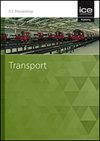城市快速公交最佳路线和站点的确定方法
IF 1
4区 工程技术
Q4 ENGINEERING, CIVIL
Proceedings of the Institution of Civil Engineers-Transport
Pub Date : 2022-07-28
DOI:10.1680/jtran.22.00004
引用次数: 0
摘要
公共交通是城市实现可持续发展的重要系统。然而,确定PT站的适当位置和找到合适的路线是关键的决定。本文旨在提出一种基于模糊推理系统(FIS)和二进制整数规划(BIP)的城市快速公交站点和路线确定新方法。在该方法中,首先根据工程判断选择一组BRT站点的潜在位置;然后,在FIS的帮助下,通过考虑几个变量,计算每个位置的权重。随后,确定了带BIP的BRT的最佳走廊。BIP模型的目标函数是最大化站点权重之和(包括BRT站点最合适的位置),同时保证每条路线的最大乘客数量。与技术、社会和经济因素有关的制约因素也被考虑在内。为了控制模型的效率,将输出与专家建议的站点和走廊进行比较。根据结果,所开发的模型最重要的特点是其简单性、能够考虑各种因素、运行时间短以及准确性高。本文章由计算机程序翻译,如有差异,请以英文原文为准。
A method to find the optimum routes and stations for Bus Rapid Transit in urban areas
Public transportation (PT) is an essential system for cities to achieve sustainability. However, determination of proper locations for PT stations and finding suitable routes are critical decisions. This paper aims to propose a novel method to determine BRT stations and routes in the cities, using Fuzzy Inference System (FIS) and Binary Integer Programming (BIP). In the proposed method, first, a set of potential locations for BRT stations is selected based on engineering judgment. Then, by considering several variables and with the help of FIS, a weight is calculated for each location. Subsequently, the optimum corridors for BRT with BIP are identified. The objective function of the BIP model is to maximize the sum of stations’ weights (involving the most suitable locations for BRT stations), while ensuring that the maximum number of passengers can travel each route. Constraints related to technical, social, and economic considerations are also taken into account. To control the model efficiency, the outputs are compared with the stations and corridor suggested by experts. Based on the results, the most important features of the developed model are its simplicity, its ability to consider various factors, a short running time, and its high level of accuracy.
求助全文
通过发布文献求助,成功后即可免费获取论文全文。
去求助
来源期刊
CiteScore
2.60
自引率
0.00%
发文量
42
审稿时长
5 months
期刊介绍:
Transport is essential reading for those needing information on civil engineering developments across all areas of transport. This journal covers all aspects of planning, design, construction, maintenance and project management for the movement of goods and people.
Specific topics covered include: transport planning and policy, construction of infrastructure projects, traffic management, airports and highway pavement maintenance and performance and the economic and environmental aspects of urban and inter-urban transportation systems.

 求助内容:
求助内容: 应助结果提醒方式:
应助结果提醒方式:


